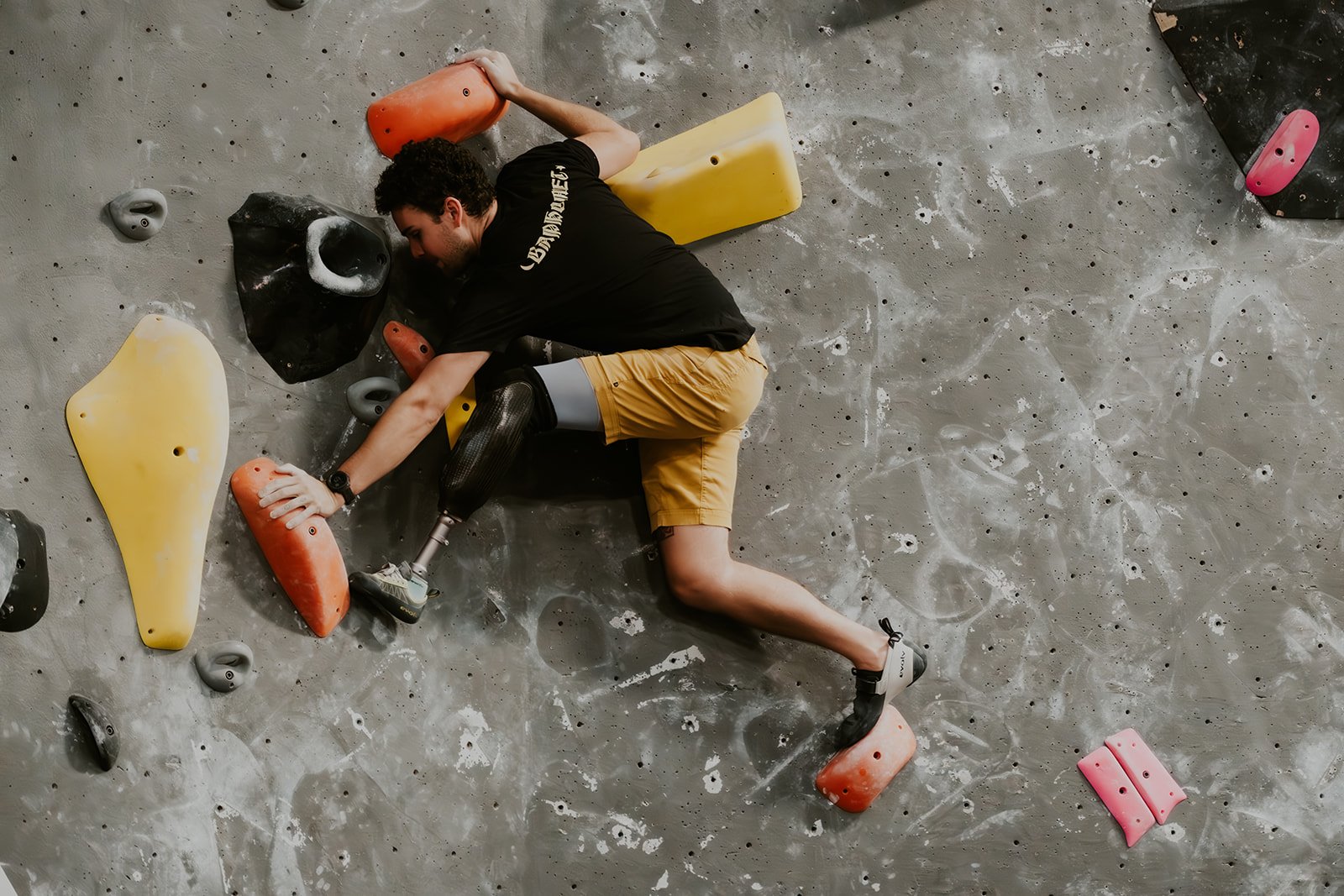First climbing competition: Boulderham
If you’re just arriving on my website, welcome! I’ll be the first to admit I’m not a writer, but I’m going to do my best to start sharing more of what life’s like as an adaptive athlete—recognizing that I know very little only a year in. So, apologies to folks here from the get-go…I’m trying my best.
Last week I did my first competitive anything since losing my left leg below-the-knee during a mountain biking accident. My foot was amputated in September 2022 and it’s been a long road to recovery, which I’m learning will be a lifelong journey. However, I used to be a competitive cyclist and I couldn’t stay away from competition forever. But, I’ve found climbing is a much easier (for me) sport to adapt to my new body. For the past 6 months or so I’ve been climbing at my local gym, and I thought the safest place to begin was Boulderham: a bouldering competition at Vital Bellingham, which is quite literally down the road from my house. I figured if it felt too hard or my body was hurting too much, I could just head home. No stress, no worries.
Instead, I had the best possible experience! My leg wasn’t hurting too much, the community that surrounded me was uplifting and kind, and I pushed my body as far as I felt was comfortable. It was so different from racing as an able-bodied cyclist, where I often pushed too hard, didn’t enjoy the overly competitive mindset of my peers, and witnessed some serious injury. Climbing has been healing for my body and spirit in a way I don’t totally have the words for yet.
What it was like to climb as an adaptive athlete at Boulderham 2023
Boulderham, where to begin? The rules of this climbing competition feel like a grand place to start.
The Rules
I had some passing familiarity with competitive climbing from watching youtube videos of events on the world stage. Competitors got on stage to do battle with gnarly climbs in front of a cheering crowd. Definitely nerve wracking. Luckily for my anxious self, Boulderham was nothing like that for us mere mortals. Instead, it was what's called a redpoint style competition.
The gym was set up for the event by the incredibly talented setters at Vital Bellingham by presenting competitors with 60 unique boulder problems. Each problem was numbered 1-60 with one being the easiest and 60 being the hardest. Competitors were given a score card where the number of attempts to top a problem were logged and once topped, two of a competitor's peers would have to sign off to confirm they had completed the problem. As such, making friends along the way to watch you climb was certainly advantageous. It never ceases to amaze me how kind and supportive the climbing community can be even in the heat of competition. In fact, this redpoint style climbing competition seems to be perfect for fostering community because it requires you to interact with other competitors. Once the allotted time was over, competitors tallied their five highest-scoring routes for their final score. For instance, if someone had only climbed routes 1-5 then their score would be 1+2+3+4+5=15.
The Vibes
But what was it actually like? Well the energy that morning was electric. People from all over had come to compete and were crowding the gym trying to stay warm. I was nervous. Boulderham was my first competitive event since my last race as a professional cyclist in 2018. I felt a pretty strong sense of imposter syndrome jumping into my first climbing competition.
Putting my climbing prosthetic on, I couldn’t help but think I didn’t belong. I thought, “I am just going to get in the way of all the able bodied competitors who want to do well.” These thoughts bounced around my head before climbing started. The staff at Vital explained the rules, and then they announced it was time to get started. I lagged behind in order to give way to all those “real climbers.” After my first couple easy climbs I started to relax, despite the crowded climbing area. I kept telling myself that I was just there to have fun and shouldn’t worry so much. It was just another day of climbing on some new boulder problems. So why did I still feel so anxious?
Walking on the matts with my prosthetic was difficult under the best of circumstances. But with the climbing area so crowded for the event, I was terrified of falling. Falling in a public place is one of those fears I never had as an able-bodied person but one that is now very high on my list of “how to induce a panic attack." It wasn’t until I truly started talking to my fellow competitors and cheering them on that all my fears took a back seat. It was abundantly clear that everyone in there was just trying to have a great time and didn’t see me as “in the way” but instead as a peer. If I fell I knew there would be an abundance of hands to pick me back up. That's when the climbing really started to feel fun.
The Routes
The setters did not go easy on us, that is for sure. The boulder problems were harder than I had anticipated. Even the lower number problems took me a couple tries to get right. Quite a few of the problems involved moves that required a deep knee bend from the left leg. Unfortunately, my prosthetic keeps me from bending my left knee more than about 90 degrees. So, some problems I had to do in unconventional ways while others I could not work around at all. These problems that I could not work around were frustrating. However, the problems I topped by adapting with unconventional moves filled me with pride. There were even a few climbs I ascended like my able-bodied peers. Quite a few problems proved to be too difficult for me but at the end of the allotted climbing time, I was proud of the work I had put in.
The takeaway? I will definitely be signing up for more climbing events in the future. Even though I came in second to last in my category, I am so proud of showing up and competing. Don't let your nerves get in the way of a good time!







